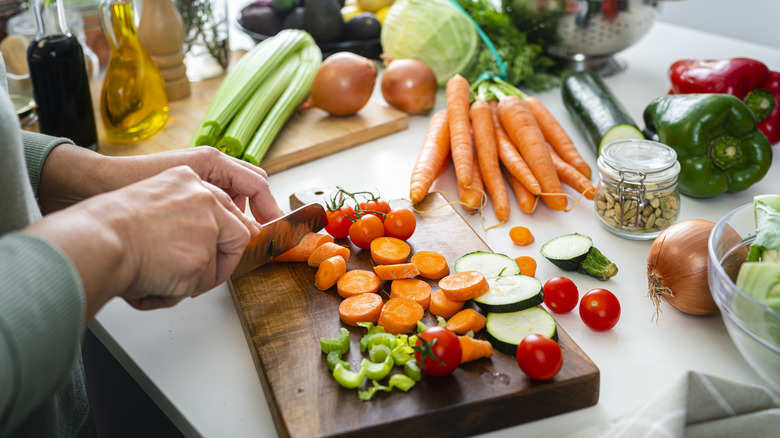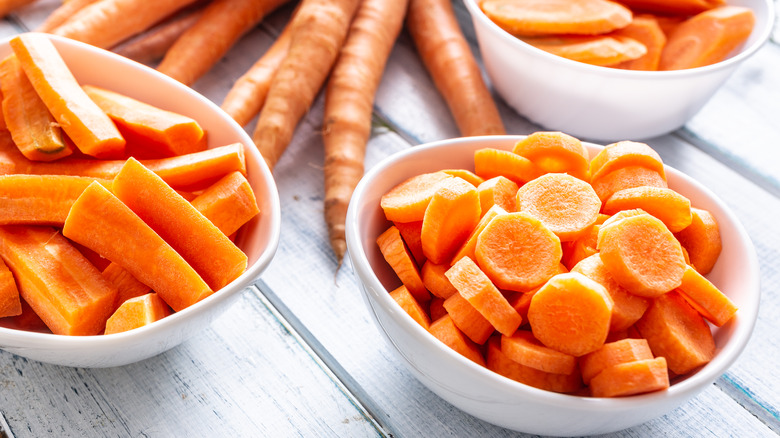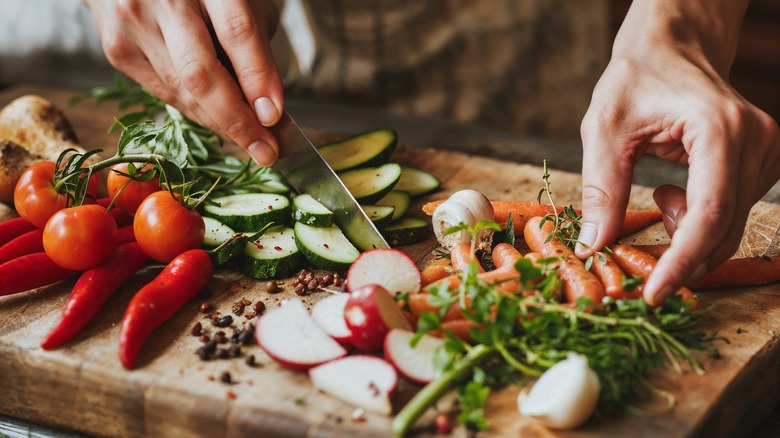What's The Difference Between A Paysanne Cut And A Rough Chop?
We may receive a commission on purchases made from links.
If you're a home cook who didn't go to culinary school, you've likely mastered lots of cutting techniques that you don't know the technical names for. Stacking your herbs into a neat little pile and chopping them into fine ribbons? You've conquered the chiffonade. Cutting identical batons of carrot and dicing them finely into perfect squares? You're now proficient at the brunoise chop. And while it isn't compulsory that you learn the proper terms for all these techniques, it can help to understand what they are to make it easier to follow a recipe that calls for julienned bell peppers or rondelle beets. Indeed, many recipes use these terms as a shorthand that encompasses how to best prep anything from celery and parsley to brocolli and radish in one word.
Chopping your vegetables in the wrong way can also have an adverse affect on the texture, appearance and taste of your meals too, which is why you shouldn't overlook terms like a "paysanne cut" or a rough chop. You might guess that a paysanne cut is just the French term for a rough chop but it's actually slightly different. It isn't a huge mistake if you use these terms interchangeably but they do have their own specific meanings.
A Paysanne cut is a rustic, uneven chop
While you may not be familiar with the term paysanne cut, you've likely done it while slicing rounds of carrot on a cutting board. This type of chop is when you slice a vegetable thinly in correspondence to its natural shape (without squaring or rounding it first). Its best exemplified when you cut an unpeeled zucchini into thin rounds or even half moons, that mirror its inherent cylindrical shape. The same goes for chopping a mushroom into slices to top a pizza where each slice has a different overall dimension but the same even thickness.
A paysanne cut is perfect for rustic, family style dishes that are thrown together quickly because the slices don't need to be perfectly uniform, unlike a baton or fine dice that's painstakingly prepared so it's identically-sized across the board. Rather, the slices may have differing diameters depending on the thickness of your vegetable from one end to the other. This cut works for anything from rutabaga and parsnip to leeks and potatoes that you might be tossing into a broth, or sauteeing with cream and garlic to make a vegetarian pasta sauce.
A rough chop means coarsely cutting ingredients into similar sizes
The term "roughly chop" means to cut your produce into pieces that are about 3/4 inch thick. Also known as a coarse chop, this type of cut is ideal when you're cooking vegetables down for a lengthy period because they can soften without completely dissolving into the liquid they're submerged in. This allows vegetables that soak up moisture like sponges — like zucchini, onions, and eggplant — to retain their structure and some of their bite, lending your dish greater textural interest. You might also employ a rough chop when making a potato soup to guarantee that your spuds don't disintegrate into the cooking broth as they bubble away. When using aromatic ingredients such as fresh coriander, mint, or garlic, a rough chop encourages the release of their natural oils, imbuing a salad or vinaigrette with an inviting fragrance.
Bear in mind that a rough chop doesn't mean that each chunk should be irregular in size. Rather, you want your ingredients to be of "roughly" the same dimensions to ensure they cook through at the same rate even if their overall shape isn't uniform. When roughly chopping root vegetables it can be helpful to use a knife sharpener first to sharpen your blade.


